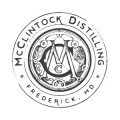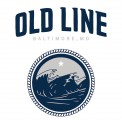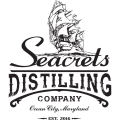An excerpt from
Chesapeake Rye – The Renaissance of Maryland Whiskey
By TW Wright
Since the beginning of the Colonial days in America, Marylanders were trailblazing what would become the state’s signature style of rye whiskey. In the decades leading up to Prohibition, Maryland along with Pennsylvania and Kentucky, were leading the nation in the production of distilled spirits and the Maryland rye whiskey was imitated and sought after throughout the land. After prohibition the Maryland whiskey industry never fully recovered and what was revived, died a slow death with the last Maryland whiskey distillery locking its doors in 1972. For over forty years, the once great Maryland whiskey lineage that spanned centuries was no more. With its recent revival, there are now conversations of what is Maryland whiskey.
 The consensus among whiskey drinkers and those in the whiskey industry, now and in the past, is that Maryland style whiskey, is Rye Whiskey. The recipe is loose, but it has a mash bill of mostly rye, a lot of corn, and a little of something else, usually malted barley but could be wheat or another grain. The recipes vary, and they always have, but it’s the spicy rye cushioned with the sweet corn and just a little hint of one or two other grains that gives Maryland Rye Whiskey its dynamic taste. It is delicate and bold, spicy and fruity, all separately and at the same time.
The consensus among whiskey drinkers and those in the whiskey industry, now and in the past, is that Maryland style whiskey, is Rye Whiskey. The recipe is loose, but it has a mash bill of mostly rye, a lot of corn, and a little of something else, usually malted barley but could be wheat or another grain. The recipes vary, and they always have, but it’s the spicy rye cushioned with the sweet corn and just a little hint of one or two other grains that gives Maryland Rye Whiskey its dynamic taste. It is delicate and bold, spicy and fruity, all separately and at the same time.
Where then did this recipe come from? Whiskey was first produced in America along the shores of the Chesapeake Bay and its tributaries. Probably first in Virginia in the first English colonies. Soon after, other settlements were established along the Virginia banks of the Chesapeake and further upstream in Maryland, and these too would begin to distil some of their grain into whiskey. This was at a time before the Caribbean sugarcane plantations were established and before the popularity of rum would take over for a duration in this region.
Initially whiskey would have been produced judiciously with the very little excess grain that may have been set aside for the purpose. But in time, as some farm land was cleared, there would be grain at the end of the harvest that could be made into whiskey. Among the first field grains to be grown was rye grass. It grew in bad soil conditions, tolerated too little and too much rain, could stand through a frost and could even be planted in the fall and would begin to grow again after the winter thaw. It was the perfect grain for the less than perfect farm plot.
From rye, the settlers could make bread, beer, and whiskey. People of that time would have rather had wheat, but wheat was more difficult to grow, and corn was still new to them. But rye was easy, or at least possible. As tobacco fields were sewn and harvested in Virginia and Maryland, rye grass was found to have a positive effect on the ground when rotated in seasonally with the tobacco plants. Some of the earliest whiskeys in America were most likely all rye.
As farmers in America began to grow more corn, some no doubt found that using some corn along with the rye made an even better whiskey. The corn added a sweetness to the spice of the rye and to someone that was accustomed to drinking whiskey that was an all rye grain mash, a good dose of corn made the whiskey just right. Too much corn though, might make the whiskey too sweet and bland for a rye drinker so the mash was kept mostly rye. Plus, corn was not as easy to grow as rye and folks in those rough times would rather use that corn for food. So corn, although an important ingredient, was usually kept a lesser ingredient to the rye, but not always.
Whiskey in the Maryland colony was often distilled three times. Most distillers in Scotland and Germany distilled their whisky and schnapps twice. But in Ireland, where the distillation of whiskey first began, the custom was to triple distill. Originally, it was a necessity to insure purity as the art was new and an impure run of whiskey could taste bad or even make one sick. The third distillation could produce a cleaner, smoother distillate, and was what the Irish became accustomed to. As the process was perfected and purity was improved and it migrated out of Ireland, the Scottish and Germans did away with the third distillation and distilled their whiskey twice. This was a loose trend, but one that was generally followed by distillers in their perspective regions.
Early on in Maryland the distillers also often distilled their spirits three times to insure purity but also because Maryland, being a colony open to Catholics, was becoming home to the many Irish Catholics who brought with them their palate for the traditional technique of triple distillation. Further north in Pennsylvania, where there were more German and Scottish immigrants the double distillation prevailed. Later in the evolution, many Maryland distillers also did away with the third distillation but the remnants of the desire for a smooth, triple distilled taste that Marylanders had in those early days, remained.
Sometimes a bit of the rye grain was malted, or some barley was malted, and added to the mash to help the fermenting process. The malting of the barley grain introduced enzymes that would jump start the yeast when added into the warm water mash. The Irish traditionally used a mix of malted and un-malted grain. This technique originated as a way to avoid a tax that was imposed on malted grain in the old world. The un-malted grain created a slightly different flavor then an all malted sprit and again, was something the Irish had become accustomed to. And since malting grain in sparse conditions of the new world could be a chore to be avoided, it was figured out that a distiller could get away with just a small amount of malted grain in the mash and still get the results of the enzymes. But this little bit of malted barley also helped to create the dynamic taste in the Maryland rye.
As for the addition of other grains such as wheat, oats, or even buckwheat, this could have been added to use up a surplus of grain or for a flavor preference of the distiller. For all of these reasons, many of the farm distillers in early Maryland along the Chesapeake began to make their whiskey in this general and loose formula.
As these evolutions were taking place in the colonies of the Mid Atlantic there was another spirit that was becoming more and more popular and that spirit was rum. It was distilled in the Caribbean and it was distilled inthe colonies from molasses imported from the islands. Rum’s favor overshadowed whisky and relegated it to being more of something to do with excess grain up until the rift between the Colonies and Great Britton known as the American Revolution. Then the British blockaded the Chesapeake during the war and cut off, among other imports, molasses and rum! Thirsty American Revolutionaries were not about to go dry in the face of battle and the American farm distillers began to do more and more of what they had been doing a little of for over a hundred years, making whiskey.
In the years following the American Revolution the consumption of whiskey in cities like Baltimore, Philadelphia, and New Orleans was great. So much so that the demand for the supply to these cities reached further and further away. The new farms in the western frontier of the Monongahela region on the
western side of the Allegheny mountains of Pennsylvania, Maryland, and parts of what was western Virginia, but would soon become Kentucky, were all producing whiskey and shipping it over roads and down rivers to these thirsty cities.
The new and unestablished farms in the western areas of Maryland and Pennsylvania were now going through the same growing pains that the Chesapeake region had gone through a hundred years earlier. They were still clearing their new farm fields and had trouble growing the more finicky grains such as corn and wheat and so their whiskey was often a high-rye whiskey with some corn and malted barley. Some early whiskey from the Monongahela region was recently found and tested and it was determined to be 80% rye grain, 15% corn, and 5% malted barley. This whiskey, although similar to what the earlier Chesapeake whiskey was like, was different from the rye whiskey with higher amounts of corn and barley that Maryland drinkers were used to by this time. And there was another difference; the whiskey was inadvertently being aged.
The ingredients and process of making whiskey had gone essentially unchanged for hundreds and hundreds of years. There is however one main thing that has changed from the early days of distilling grain to what we now know as whiskey. In fact, the whiskey of olden days would not even be able to be called whiskey by today’s legal standards. From the earliest beginnings of distilling grain, the process had gone from grain to mash to the still and then into an earthen pot or clay jug or pan or bottle or any other thing that one might have to hold their whiskey long enough to transport it and to later enjoy; but not necessarily a barrel.
Wood barrels since their inception were used for the storage of any and all things. Barrels were then, as they are today, a difficult thing to make and good barrels that were watertight were cherished. A farmer might have used a barrel to store and keep his grain dry as he moved it and sold it to the mill. From there he might use that barrel to bring back to his town fresh oysters alive in his barrel full of bay water. On emptying that barrel its next use could be anything from pickling vegetables or souring cabbage.
Each time the farmer would give every attempt to clean the barrel of remnants from the previous load using the limited washing means he had available, often with boiling water. Even with these attempts to clean the barrels, the varying nuances and aromas could leach into and remain in the fibers of a barrel. The general thought of the time was that a barrel, although a good vessel to collect and move whiskey to a market, was not a good place to store whiskey for very long, or run the risk of possibly picking up some offensive flavors or smells of a previous cargo. Not to say that barrel aging did not exist at all, wines were stored in wood barrels for periods of time and ports and madeira were making the transatlantic trip in oak casks, but the practice of barrel aging whiskey as a rule did not begin until into the 1800s. Intentionally aged whiskey was just not a part of the flavor profile that imbibers were seeking in those days.
Take the whiskey that was made at the Dill Tavern in Dillstown (now Dillsburg), PA in the early 1800s for example. We can deduce from their old ledgers listing the amounts of grain they purchased for the distillery that their whiskey mashbill was rye, corn, and barley, so they made a Maryland style rye. This makes sense since it was to be sold in Baltimore and it also makes sense because Leonard Eichelberger, the proprietor and distiller, was from Frederick, Maryland. It was barreled and shipped to Baltimore by wagon. The trip took ten days and that’s how long the whiskey spent in the barrel. The barrels were then offloaded, and the wagons reloaded with barrels of oysters in brine-water and other goods to be used or sold back in Dillstown. Ten days with maybe a few more on the front and back end is not a long time in a large, used barrel and would be considered essentially unaged by today’s standards.
Then as demand increased and the whiskey production moved further west into the Monongahela region of western Pennsylvania, there was a greater delay in the transport of the whiskey from the farms on the other side of the Alleghany mountains to Baltimore and Philadelphia in the east. The weather there was not as congenial as it was on the eastern side of the mountains and the harvest would be a rush to bring in the crops before the frost. Then, when time would finally permit after the harvest, the farmer would begin to distill. Once his spirits were completed the first snows would have already settled in the mountains making a trip over them with a wagon heavy with barrels of whiskey treacherous. At the spring thaw, the trails would turn to mud for weeks and the farmer might not be able to navigate the mountain passes until well into spring. The whiskey would spend a much longer time in the barrel then the ten days it took to get rye from the Dills Tavern to market.

Knowing that his spirits would have to spend months in a barrel the distiller would choose to keep barrels for only that use; not allowing them to become tainted with obnoxious smells and tastes. He would also clean the barrels as best as he could before using them to store his spirits. And as was sometimes done to purify the wood in a barrel, he might place his barrel over a fire and allow the flames to purify and dry the wood staves, affectively charring the inside.
This un-aged whiskey would now spend months in a charred oak barrel. By the time it was delivered to Baltimore it would have taken on the charred oak flavor with the smells of vanilla and caramel and the reddish-brown color that we now all associate with all whiskeys. Initially this was an unintended effect. Very soon customers began to enjoy this new kind of red colored whiskey and asked for it. The difficulty in this at the time was that there was no name for it. People began to call it “Red Whiskey” and in years it came to be known as Monongahela whiskey after the river valley that ran through the western part of Pennsylvania where this kind of whiskey came from.
In effect, this, along with the high rye content of the mash bill of this whiskey became terroir of the Monongahela Rye. This was also happening in other regions for the same reasons as whiskey traveled further and further down rivers and over roads to get to places like New Orleans, Philadelphia and other growing cities. This style of whiskey that was at first, unintentionally aged in quality white oak barrels, became wildly popular and distillers and rectifiers in other regions began to store their whiskey in the same way for a period of time in order to achieve the same effect.
As the Maryland farmers began aging their whiskey too, their Maryland style whiskey with rye, corn, and barley also benefited from the charred white oak. Now many customers would find this Maryland style of rye whiskey to be their favorite and wanted to be able to ask for it by name. It was this need to be able to articulate their whiskey apart and different from the Monongahela whiskey that the term “Maryland Rye” began to be used. Even though Maryland had been making whiskey in their style much longer than the Monongahela region had, it was because of the establishment of Monongahela whiskey as a style of whiskey, that Maryland style whiskey earned its moniker.
“Maryland whiskey” is the name, and the style, that has been used and touted by hundreds of distilleries over the years. Maryland rye whiskey became famously popular during the Civil War by the thousands of Union Soldiers who learned to love this style while being garrisoned in Maryland to protect Washington, DC. Their thirst for Maryland rye was then transplanted throughout the northern states during and after the war as the veterans returned to their homes.
Since that time there have been hundreds of whiskies that have identified with the Maryland style. Old whiskeys now gone like, Maryland Rye Whiskey, once distilled by John H. Waters & Co in Boston, MA. Another called Maryland Rye Whiskey, was distilled by Sadler Mercantile Co out of Salt Lake, CO, and Old Tavern Brand Maryland Straight Rye Whiskey, that was made by The American Liquor Company in Boston, MA. The list goes on and on to remind us that once, generations ago, everyone wanted to be Maryland Rye.
Knowing that it was once the most sought-after style in America and even popular in Europe, it’s a wonder why it could have ever fallen out of favor in the first place. After Prohibition, Bourbon whiskey with its high-corn recipe was undoubtedly the most popular style. Often whiskey presenters like to make easy talk of the evolution to Bourbon and say that during Prohibition imbibers became accustomed to the corn whiskey that was bootlegged to the speakeasies and so after prohibition everyone wanted Bourbon. This is only slightly true.
To begin with, Bourbon was being made in huge quantities in Kentucky prior to Prohibition. Kentucky already out-produced little Maryland in the years before Prohibition and their high-corn style was already very popular. And one of the main reasons that Kentuckians had originally began making whiskey with so much corn was due to promises of free land if they grew corn and built a house in the area to become Bardstown. This created surpluses of corn. But they could have also grown rye and used that with their corn and made rye whiskey instead of Bourbon if they had so chosen and in some cases, did.
Marketers like to tell us why Bourbon is better than rye. We always hear about the soft water in Kentucky. This is true that Kentucky has limestone filtered water that is great for making whiskey. But to look at a geological ground water softness chart you will see that the ground water in and around Baltimore is actually just as good as that of Kentucky’s ground water. So, it’s not just that alone either.
Another reason, not so much for the rise of Bourbon but rather the decline of rye and the Maryland distilleries after Prohibition was simply that many of the distilleries in Maryland that were producing prior to Prohibition were in urban areas. These properties were in valuable locations and the need to sell off the property during the thirteen years of Prohibition was too great to resist. In Kentucky many of the distilleries were in more suburban and agricultural areas where the demand for that property was not as great and so the sale of distilleries was not so tempting. Not to mention that more than a few of these distilleries were still producing legally for medical purposes.
When Prohibition ended, the Kentucky distilleries that had been mothballed went back into action. The ones that had continued to distill on a limited basis had already ramped up their production seeing the end of the Noble Experiment coming. Conversely, most of the Maryland distilleries were sold. Many that were restarted were now run by different people then those that had operated them prior to Prohibition. Often the old distilling family’s commitment to quality had been sold off to someone interested to make quick money on the reputation of Maryland whiskey; many of whom failed within a decade. Of those that did maintain, many were bought up by large whiskey conglomerates that were mostly interested in buying up the old famous Maryland names only to sell blended whiskey, a pale shadow of the once great Maryland rye.
One of the least discussed reasons for the switch in popularity from Rye to Bourbon is simply that young imbibers are always looking for new trends. When I was young, the popular cocktail was a Margarita, then it switched to the Mojito, and then the for no particular reason switched to the Moscow Mule. I’m sure there is now some new cocktail these days that I’m just not hip enough to even know about.
People like to find new styles. It doesn’t mean that there is, or ever was, anything wrong with the old style, just that people are always thinking about the next new thing and if something good comes along that’s reason enough to switch. Bourbon came along, and it was good, and folks liked it.
Now in recent years, the fame of Maryland rye whiskey has returned. There are distillers around the country again making whiskies that proclaim to be of the Maryland rye whiskey styl e. Distilleries like New Liberty Distillers in Philadelphia, PA, New England Distilling in Portland, ME, Leopold Bros, in Denver, CO, and Far North Spirits in Hallock, MN, all have whiskies labeled to be Maryland style.
e. Distilleries like New Liberty Distillers in Philadelphia, PA, New England Distilling in Portland, ME, Leopold Bros, in Denver, CO, and Far North Spirits in Hallock, MN, all have whiskies labeled to be Maryland style.
Even the celebrated and highly awarded Pikesville Straight Rye, a Maryland style rye, made by Heaven Hill in Kentucky, was originally made in Maryland near the town of Pikesville. Pikesville Rye was the last of the great Maryland ryes to cease operation in the 1970’s. The distillers at Heaven Hill just couldn’t bear to see the Maryland whiskey legacy go completely away and so they bought the recipe and the name and made Pikesville Supreme, a Maryland style rye whiskey for decades that could only be found in and around Maryland. Heaven Hill’s recent version of Pikesville Supreme, which is called Pikesville Straight Rye has won awards and is introducing a new global generation to Maryland style rye. And now of course, there are many new craft distilleries in Maryland that have also embraced this rich old heritage of the Maryland style rye whiskey and are producing versions of their own.
Perhaps, partly for this same reason, Maryland Rye has made a huge comeback. Bourbon is still as good as ever. But people are always looking for the next good thing and many have rediscovered Maryland Rye. First, for its great inherent qualities that make it an excellent spirit for classic cocktails like Manhattans, Sazeracs, Whiskey Sours, and Old Fashions; all originally made with rye. Also, for its ability to mix wonderfully into all of the new hip cocktails. And of course, the whiskey connoisseurs, love to sip Maryland Rye all by itself.
And now there over fifteen new distilleries in Maryland making rums, brandies, liquors, unaged whiskey, corn whiskey, Bourbon, and many of course, are making Maryland Rye. We can once again taste the commonalities in the category of Maryland rye and still explore all of the individual characteristics of the different whiskeys from the distilleries around the state.






































